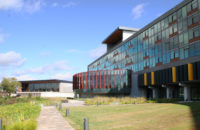Says Kercsmar: "The end result is a system that will allow NASA to diversify its capabilities for processing multiple rocket configurations without the need for major reconfiguration or heavy construction modifications to either the extensible platform system or VAB structure in the future, saving both schedule and cost."
At the same time that NASA is adding in these assembly platform systems, contractors and engineers are upgrading a wide array of existing building infrastructure that the agency's analysis proved was in "critical" need of repair or improvement.
These "refurbishments," as NASA calls them, are extensive and far-reaching, literally.
"Just to get to some of these places is a monumental task," says Steve Starr with Vencore, NASA's program manager for engineering services. "Access is one of the major issues we think about as we're going through this whole process."
The repairs start with the VAB's massive steel structure and involve either completely replacing or adding in steel plate to existing structural supports. Some existing beams measure 4 ft to 5 ft deep, for instance.
"In some places, we're welding plate on the top and bottom of the W sections in order to strengthen it," Starr explains. In other locations, steel connections need "beefing up," a task that is being handled in varying ways, depending on conditions.
Due to the scope of the steel upgrades—spread across the building's area of nearly 3.7 million cubic meters—this work will be ongoing for nearly the full course of construction.
"We're building the platform from the bottom up," Starr says. "We're beefing up the structure before we put the platform levels in."
Additionally, because the SLS is heavier than previous NASA vehicles, crews have to install micropiles in certain locations to extend the pile caps, says Starr. These foundation repairs are isolated, however, to two areas that support the mobile launch platform, which will carry the rocket from the VAB to one of two nearby launch pads.
Other structural improvements include rehabilitating spalled concrete on between 100 and 150 sections of elevated slab; removing more than 150 miles of abandoned copper cable in favor of fiber optics; and taking down the 45-year-old, 175-ton crane that operates near the top of the VAB in order to modernize it with digital controls before reinstallation. Also, in order to bring fire-protection systems up to modern code, crews will install larger piping for water.










